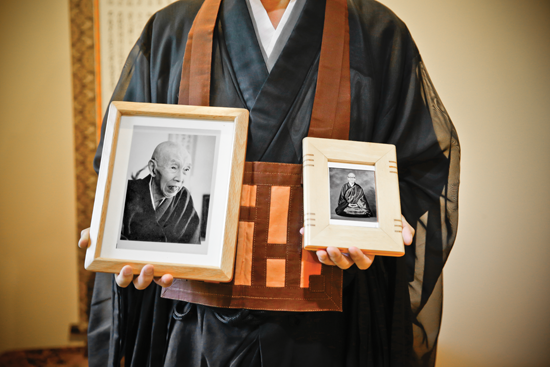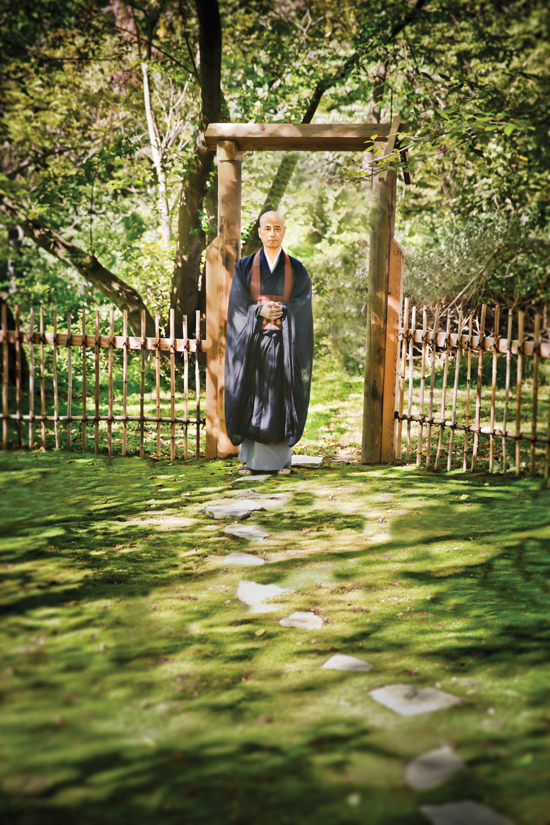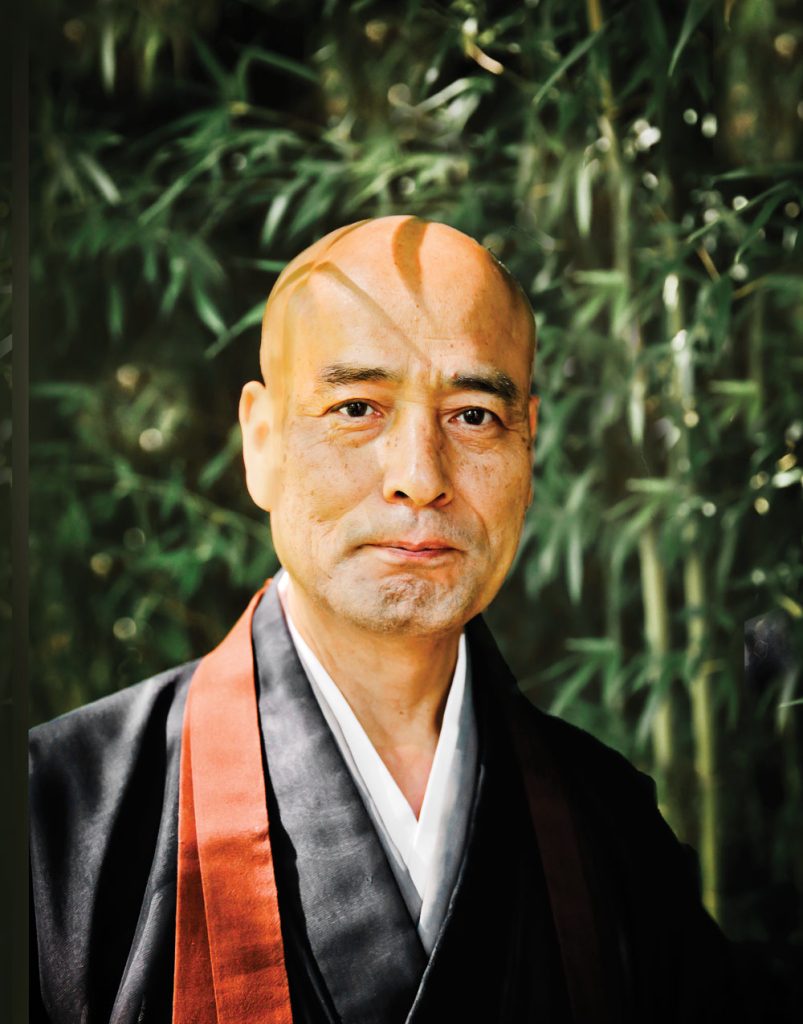The Zen Teaching of Homeless Kodo (Wisdom Publications, fall 2014) features the wisdom of three generations of Zen masters: Kodo Sawaki Roshi (1880–1965), Kosho Uchiyama Roshi (1912–1998), and Shohaku Okumura (1948–). “Homeless Kodo” refers to the first in this dharma line, Kodo Sawaki, who powerfully revived and popularized the Soto Zen practice of shikantaza, or “just sitting”—as distinct from the Rinzai Zen school’s focus on koans—by bringing the practice outside Japan’s monasteries to its laypeople. An itinerant teacher for most of his life, he established in 1949 Antaiji Shichikurin Sanzen Dojo, a still thriving Buddhist temple now in Hyogo Prefecture. After Sawaki died, his dharma heir, Kosho Uchiyama Roshi, published a collection of brief sayings by Sawaki with commentaries of his own. The Zen Teaching of Homeless Kodo is that book, now newly translated and amplified with additional comments and explanations by Uchiyama Roshi’s disciple Shohaku Okumura.
Homeless Kodo is a beautiful book, plainspoken and deep. Its editor, Jokei Molly Delight Whitehead, wrote in her preface: “My favorite aspect of this book is its prismatic reflection of a single truth through the distinct characters, experiences, and voices of three teachers—the universal manifesting through the particular, as always.” I couldn’t agree more, nor could I say it better.
My first acquaintance with Shohaku Okumura, a native of Japan who is now the head teacher at Sanshin-ji in Bloomington, Indiana, was in July 2013, at a retreat that combined silent sitting meditation with the study of two brief texts from Shobogenzo, the masterwork of the Soto Zen master Eihei Dogen (1200–1253), in Shohaku Okumura’s translation. Reverend Okumura and I conducted our interview over the phone, he in Indiana, I in New York. There is no distance and no separation when two minds meet in a spirit of simple openness and truth.
—Joel Agee
When you were 17 years old, you read a book by Kosho Uchiyama Roshi that impressed you deeply. It made you want to live like him and become his disciple. What was the quality or the message in Uchiyama’s book that spoke to you so strongly? When I was 17, it was the mid-’60s. I had many questions about life, about my own path and also about the situation in Japan and in the world. It was the time of the Vietnam War and the Cold War, and the Japanese people were working hard—too hard—to make money and help Japan become a rich country. I felt like this entire Japanese society was one huge moneymaking machine, and that school was a factory to produce parts for that machine. I was being asked to study hard and go to a prestigious university so that I could get a good job after that. I couldn’t find any meaning in that. I wanted an alternative, a different way of life. I wanted to drop out of that machine existence—that kind of goal-oriented, greedy way of life—but I didn’t know if that was possible, and that was why I started to read many books on philosophy, religion, literature, and so on.
In that process I came upon Uchiyama Roshi’s book and found that when he was a teenager he had the same kind of questions I had: What is the truth? What is the meaning of life? He searched for an answer in Western philosophy and graduated from Waseda University with a master’s degree in that subject. Then he became a teacher at a Catholic seminary. Later he became a Buddhist monk under the guidance of Sawaki Kodo, and he found his answer. And after finding his answer, he continued to study and practice and share the way of life he had found with younger generations. I knew there had been many such people in human history. But Uchiyama Roshi was the first person I had heard of who lived that way in my time and in my country. I was very inspired, because I could see that there was a different way that I could walk. That was what I felt.
You wrote that you wanted to attend sesshin with him right away, but something got in the way. Yes. That was both fortunate and unfortunate. It was unfortunate because I would have had a chance to meet Sawaki Roshi, who was at Antaiji [the temple Sawaki Roshi founded] at the time. He died a few months later. But it was fortunate too, because if I had gone to Antaiji at the age of 17, it could have turned me away from Zen. I wasn’t ready for sesshin. Instead, I went to Komazawa University to study Buddhism and Zen. And only later, when I was 20, I went to Antaiji and became Uchiyama Roshi’s disciple.
What was Zen practice with Uchiyama Roshi like? When I practiced with him at Antaiji, we had a Sundayzazenkai [a one-day zazen retreat] every other week, except when we had sesshin, and he gave two lectures, usually on Shobogenzo [the major work of Dogen Zenji (1200–1253), founder of the Soto school of Zen Buddhism], every Sunday. After he retired from Antaiji when he was 63—which was still very young for a Zen master, but he had to retire because of his physical condition—he gave lectures at a temple in Kyoto once a month for more than ten years. The transcription of his lectures on Shobogenzo became books, and I think more than 10 books of this series were published. And he also wrote several books of his own, so all together he published more than 20 books. He was a very intellectual person who could give explanations about Zen practice and dharma in a very attractive and understandable way for modern people.
Uchiyama Roshi was Sawaki Kodo’s disciple. They were close friends, but it seems they were very different as human beings. Can you say something about that? It had partly to do with their different backgrounds. Sawaki Roshi came from a poor family. He had a very hard time in his childhood and studied and practiced by himself when he was young. Uchiyama Roshi came from a wealthier, more educated family. But Uchiyama Roshi was a very weak person physically, already as a child and especially after his early twenties, when he contracted tuberculosis, which he lived with the rest of his life.
Sawaki Roshi was a strict and tough Zen master, but Uchiyama Roshi was a gentle and kind, innocent sort of person. But, of course, he was mentally tough too. He practiced zazen deeply and devoted his whole life to Zen after he became a monk. So he was gentle to other people, but in his own mind he had no fear of sickness and dying. He was also an intellectual, as he studied Western philosophy in university. So his way of teaching was very understandable to young people.
You know, traditionally Zen masters were very tough on their students, always scolding them and never giving reasonable orations or explanations about practice or dharma. But Uchiyama Roshi could always give us logically understandable explanations of what zazen is. In that sense he was very unique. After Sawaki Roshi died, people said that he was the final, or last, Zen master, but when Uchiyama Roshi took over at Antaiji from Sawaki Roshi, Uchiyama Roshi said, “I will try to be the first Zen master for the modern time.

Sawaki Roshi is widely credited with having transformed Zen practice in Japan. What would you say was his unique achievement in that respect? Well, he was called “Homeless Kodo” because he did not have his own temple or monastery. From the time he was around 40, he started to travel all over Japan to lead sesshin or zazenkai and give dharma talks at the temples or at private homes or wherever he was invited. He continued to practice in this way until he was 83. During 50 years of ceaseless traveling and teaching, many laypeople started to practice. Before this, laypeople were not encouraged to practice zazen; it was considered a practice for training monks at monasteries. So thanks to Sawaki Roshi’s great effort and skillful instruction, as well as his strong, humorous personality, very many Japanese people were inspired to practice zazen.
Commenting on his nickname, Sawaki said, “All human beings, without exception, are in reality homeless.” In your commentary you mention the noble homelessness of the bodhisattva, who out of compassion renounces nirvana but out of wisdom does not reside in samsara either. What does Sawaki mean by the homelessness of all human beings without exception? That is his unique way of expressing what Buddha taught, that it’s not possible to possess anything because everything is impermanent and without substance. So actually there’s no dwelling place for anybody. Once a friend of his, one of his students, was dying. He was still young, maybe in his forties or fifties. When Sawaki Roshi visited him, the sick man said, “I cannot die. I cannot die when I think of my family. How can they live without me, especially my children?” Then Sawaki Roshi said to him: “Don’t worry. You can die.” I think this is very compassionate, to make this person see or feel the reality of his life.
I understand you are married and have a family. Practice in a zendo is intricately ordered and regulated, but family life, particularly when there are young children, is full of unpredictable currents and crosscurrents of emotion. How do the two go together? Does family life enrich your practice? Does it complicate it? Is it a challenge? Well, it’s a challenge, of course. To be a Buddhist practitioner with a family is difficult but, in my case, I feel my practice and my spirituality have been enriched by having a family. I ordained as a monk when I was 22. For more than 10 years I practiced without a family, so I could really dedicate my life to practice and nothing else. But when I reflect on that period, I can see that I felt superior to people who didn’t live the way I did. I was devoted to good-for-nothing zazen, while they worked to make money and raise families. I thought my life was better than theirs, even though I didn’t really know how other people lived. I think that was a very—how can I say—arrogant idea.
But after I turned 30, when I was practicing in Massachusetts, my body was half broken because of too much hard work. So I could no longer practice in the way I had in my twenties and I had to give that up. Until then, Dogen Zenji had been the hero of my life. But I found that I couldn’t live like Dogen. And after that, Ryokan, the 18th-century Buddhist monk and poet who lived much of his life as a hermit, became my hero. He was someone who was not, you know, a great, strong Zen master but a humble person, just being, equal with all other beings. I don’t think Ryokan looked down on common people. So that’s why I decided to marry and have a family. And after I had found somebody, of course it made my practice more difficult. I couldn’t be 100 percent free and devoted to dharma. So combining practice with family is a challenge, but having a family makes me more flexible and humble, so I appreciate having one.
You know, the difficulty showed up very clearly when my daughter was born. She is now 26 years old, so 26 years ago we expected her birth during the Rohatsu sesshin [the seven-day sesshin that commemorates the Buddha’s enlightenment]. I couldn’t cancel that sesshin. So we started to sit, and my wife, who usually did tenzo [the chef at a monastery], was about to give birth. We didn’t know when the child would be born, so my wife and I had a very serious discussion about what we should do if the baby was born during sesshin, whether we should stop doing sesshin and whether I would go to the hospital with my wife or continue to sit. It seemed almost impossible to make a decision. So I asked my daughter if she could wait to be born until after sesshin was over. And she did that for us. Her birthday is December 9. We sat until December 8.
You just mentioned “good-for-nothing zazen.” I assume that was a reference to one of Sawaki’s sayings: “Zazen is good for nothing.” I think I understand the meaning of that. Zazen has no ulterior purpose; it’s not a means to an end. Yet surely zazen is good for something—otherwise we wouldn’t do it and Sawaki Roshi wouldn’t have encouraged people to practice it. The first time I heard this English expression, “good for nothing,” I was living in Massachusetts. One summer, to support our practice, we worked for a farmer harvesting blueberries. There were some high school students working there too, as a summer job during their vacation. There was a part of the field were another kind of berries were growing, called dogberries. The students were not very careful, so sometimes they mixed dogberries in with the blueberries. The farmer was always shouting: “Stop picking those good-for-nothing dogberries!” I really liked this expression, “good for nothing,” and I thought, “What’s the difference between those good-for-nothing berries and the blueberries?” Dogberries are not edible, but they are pretty. Blueberries are pretty, too, but they are also edible, so they have market value. That means they’re “good for something.” Dogberries have no market value so we consider them “good for nothing.” But when we put aside our human evaluation, then blueberry and dogberry are the same. They are both pretty and just live to continue their lives. So I thought, dogberries are good but for nothing. That’s why I translated Sawaki Roshi’s expression that way: “Zazen is good for nothing.” To me, this means zazen is good—but not for something. It is good in itself. I think this is very important. It is the same as what Bodhi-dharma said when the Emperor Wu told him he [the emperor] had helped Buddhism by creating hundreds of temples and monasteries and asked what karmic rewards he could expect. Bodhidharma said, “No merit at all.”
Soto Zen is sometimes talked about as Zen without satori [sudden realization or enlightenment]. Is this correct? How does the distinction between gradual and sudden enlightenment apply to Dogen’s Zen? This depends on the definition of satori. Dogen Zenji often said, “Practice and enlightenment, or satori, are one.” That means our practice of zazen is itself enlightenment. In that sense, this is very sudden. When we sit, enlightenment is there. But we still need to continue this practice endlessly, so that within the process of practice, we become a deeply matured person, and that is very gradual. So in our practice, both gradual and sudden enlightenment are there.

What is the definition of satori in the context of Dogen’s practice? When Dogen said “practice and enlightenment are one,” he used the Chinese words shu and sho. Shu is practice and sho is enlightenment, but the actual meaning of sho is “evidence,” “verification,” or “proof.” This shu-sho is an abbreviation of a longer expression, mon-shi-shu-sho, which means “to hear,” “to think,” “to practice,” and “to verify.” It refers to the way we practice Buddhism. We hear the teachings, then we think about what we have heard, and if the teaching makes sense and seems doable for me, I put it into practice. And as we practice, we see or we know in our experience that the teaching was true. That is what verification means.
Seeing that it is true. Yes, that the teaching was true or correct or right. Through our practice, we found it. That is what verification or evidence means in this case. And when Dogen then said, “Shu and sho, or practice and verification, are one,” that means, within our practice, this verification is already there. But that means our practice is itself the verification of the truth of the teaching. And that teaching means that we are living together with all beings, interconnected with all beings, and when we sit we really become part of this network of interdependent origination. That’s why Dogen said this practice is itself verification, and in this case, verification is what satori means: we really see that we are connected with all beings. This awakening that we are together with all beings is satori, in my understanding. And within our practice of zazen, this satori is already actualized.
This is very different from the commonly held idea of satori that D. T. Suzuki wrote about in his books: “the sudden flashing into consciousness of a new truth hitherto undreamed of.” Yes, that is the Rinzai approach of koan practice, where satori is the goal of the practice, something we need to achieve. Dogen’s approach is a little—actually, not a little but very different. Dogen said, “We don’t practice to attain enlightenment, we practice being confirmed by enlightenment.”
That’s why it’s good for nothing. Yes.
Thank you for subscribing to Tricycle! As a nonprofit, we depend on readers like you to keep Buddhist teachings and practices widely available.
